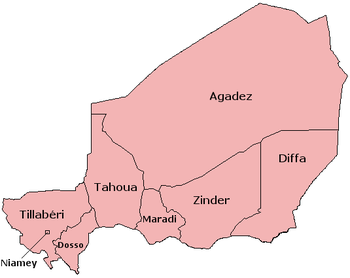Parts of this article (those related to creation of 27 departments in 2011) need to be updated. (March 2024) |
Niger is governed through a four layer, semi-decentralised series of administrative divisions. Begun 1992, and finally approved with the formation of the Fifth Republic of Niger on 18 July 1999, Niger has been enacting a plan for decentralisation of some state powers to local bodies. Prior to the 1999-2006 project, Niger's subdivisions were administered via direct appointment from the central government in Niamey. Beginning with Niger's first municipal elections of 2 February 1999, the nation started electing local officials for the first time. Citizens now elect local committee representatives in each commune, chosen by subdivisions of the commune: "quarters" in towns and "villages" in rural areas, with additional groupings for traditional polities and nomadic populations. These officials choose mayors, and from them are drawn representatives to the department level. The departmental council, prefect, and representatives to the regional level are chosen here using the same procedure. The system is repeated a regional level, with a regional prefect, council, and representatives to the High Council of Territorial Collectives (Le Haut Conseil des Collectivités Territoriales HCCT). The HCCT has only advisory powers, but its members (regions, departments, and communes) have some financial, planning, educational and environmental powers. The central government oversees this process through the office of the Minister of State for the Interior, Public Safety and Decentralization.[1][2][3][4]

- ^ (in French) NIGER. Situation institutionnelle Archived 2008-11-26 at the Wayback Machine. Sory Baldé, CEAN, IEP-Université Montesquieu-Bordeaux IV.
- ^ http://www.communication-gouv-niger.ne/ Archived 2008-03-23 at the Wayback Machine Government communications office of Niger.
- ^ French Ministry of Foreign Affairs: Niger information Archived 2010-01-23 at the Wayback Machine.
- ^ United States Library of Congress: Guide to Republic of Niger Law Online.